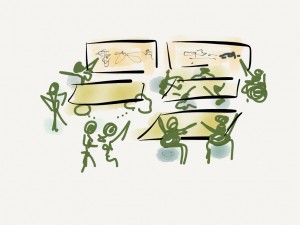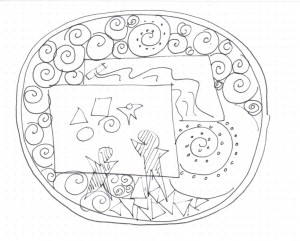 Clark Quinn has a great provocation on his blog today. I ‘ll share a quote, then reply.
Clark Quinn has a great provocation on his blog today. I ‘ll share a quote, then reply.
So, many of the things we’re doing are driven by bad implementation. And that’s what I started wondering: are we using smart technology to enhance an optimized workforce, or to make up for a lack of adequate preparation? We could be putting in technology to make up for what we’ve been unsuccessful at doing through training and elearning (because we’re not doing that well).
To put it another way, would we get better returns applying what’s known about how we think, work, and learn than bringing in technology? Would adequate preparation be a more effective approach than throwing technology at the problem, at least in some of the cases? There are strong reasons to use technology to do things we struggle at doing well, and in particular to augment us. But perhaps a better investment, at least in some cases, would be to appropriately distribute tasks between the things our brains do well and what technology does better.
Let me be clear; there are technologies that will do things more reliably than humans, and do things humans would prefer not to. I’m all for the latter, at least ;). And we should optimize both technology and people. I’m a fan of technology to augment us in ways we want to be augmented. So my point is more to consider are we doing enough to prepare people and support them working together. Your thoughts?
Source: LearnletsTechnology or preparation? – Learnlets
 While Clark’s question is in the context of workplace learning, it is resonant in far wider contexts. I see it when I’m asked to design group process and gatherings. We are constantly putting “band aids” on instead of addressing underlying issues. We don’t really “prepare people and support them working together.” Why is that? Is it the continued desire for a quick fix, or the deep denial that how we work together matters and making it work more effectively might challenge too many things: power, status quo, cost?
While Clark’s question is in the context of workplace learning, it is resonant in far wider contexts. I see it when I’m asked to design group process and gatherings. We are constantly putting “band aids” on instead of addressing underlying issues. We don’t really “prepare people and support them working together.” Why is that? Is it the continued desire for a quick fix, or the deep denial that how we work together matters and making it work more effectively might challenge too many things: power, status quo, cost?
The observation of this problem is neither new nor unique… it is how things often work. So the question is how do we better shine a light on the underlying issues and take immediate steps — however small – for remediation? Rather than throw up our hands and say it is too messy, hard or difficult?
This is where complexity-informed practices come in. From the deep dives into understanding what is happening with sense-making tools like Cognitive Edge’s Sensemaker, to simple, reproducible group practices like Liberating Structures, we can stop shrugging our shoulders and saying “that’s out of my scope of work” or “I can’t do anything about that.” The point is we have to do SOMETHING. Not just plow on from tech innovation to tech innovation. Here are four possible sets of practices that could help us go deeper and do better. Here are four possible sets of actions.
Creative Destruction to Make Space
 What one thing, no matter how tiny, can we stop doing to make space for the things we want to try? Before we add a new technology, do we stop using another one? Before we seek a solution to an efficiency problem, can we find out what to stop doing that caused the problem? Cue up Ecocycle or TRIZ, and make some of these now-useless activities visible. So often we strive to manage and scale when we have either grown past the things we are scaling, or they are no longer fit for purpose. We operate in mostly dynamic environments, yet we try and shoehorn everything into an ordered domain. (The complicated and simple in the Cynefin framework. In an ordered domain “cause and effect are known or can be discovered.” Complex and chaotic domains are understood as unordered, where ” cause and effect can be deduced only with hindsight or not at all.”).
What one thing, no matter how tiny, can we stop doing to make space for the things we want to try? Before we add a new technology, do we stop using another one? Before we seek a solution to an efficiency problem, can we find out what to stop doing that caused the problem? Cue up Ecocycle or TRIZ, and make some of these now-useless activities visible. So often we strive to manage and scale when we have either grown past the things we are scaling, or they are no longer fit for purpose. We operate in mostly dynamic environments, yet we try and shoehorn everything into an ordered domain. (The complicated and simple in the Cynefin framework. In an ordered domain “cause and effect are known or can be discovered.” Complex and chaotic domains are understood as unordered, where ” cause and effect can be deduced only with hindsight or not at all.”).
Space for Uncertainty and Experimentation
 Maybe certainty and obsession with technical fixes is overrated. Earlier this week I participated in an online gathering hosted by Johnnie Moore on Unhurried Conversations. He offered five principles to support unhurried conversations and one was The wisdom of uncertainty. We can use uncertainty to experiment our way into useful solutions, rather than coming up with a “brilliant idea” that may inadvertently build on past weakness. We may miss the underlying preparation. We can use Improv Prototyping to “act our way into knowing.” We can use Helping Heuristics to strengthen our listening before we pounce with our own (half baked?) ideas, giving space to considerations that are lost for those of us who “think by talking.”
Maybe certainty and obsession with technical fixes is overrated. Earlier this week I participated in an online gathering hosted by Johnnie Moore on Unhurried Conversations. He offered five principles to support unhurried conversations and one was The wisdom of uncertainty. We can use uncertainty to experiment our way into useful solutions, rather than coming up with a “brilliant idea” that may inadvertently build on past weakness. We may miss the underlying preparation. We can use Improv Prototyping to “act our way into knowing.” We can use Helping Heuristics to strengthen our listening before we pounce with our own (half baked?) ideas, giving space to considerations that are lost for those of us who “think by talking.”
Leadership for Spotting and Picking Up Promising Experiments
 When we start getting seduced by technological innovation, it reminds me that there are people who see the world differently and can look within and beyond the tech itself and spot the ideas for promising experimentation. Not everyone has these skills to imagine things. We want solutions and we tend to foreclose on them too quickly, or fail to do, as Dave Snowden loves to say, “safe fail” experimentation to test our assumptions and asses the complexity (or not) of a situation. Sometimes that means we are smart enough to notice others with these strengths, and not try and be the “solution maker” ourselves. Approaches such as Wicked Questions , Discovery and Action Dialog, and Critical Uncertainties can help us spot the things we might otherwise rush by.
When we start getting seduced by technological innovation, it reminds me that there are people who see the world differently and can look within and beyond the tech itself and spot the ideas for promising experimentation. Not everyone has these skills to imagine things. We want solutions and we tend to foreclose on them too quickly, or fail to do, as Dave Snowden loves to say, “safe fail” experimentation to test our assumptions and asses the complexity (or not) of a situation. Sometimes that means we are smart enough to notice others with these strengths, and not try and be the “solution maker” ourselves. Approaches such as Wicked Questions , Discovery and Action Dialog, and Critical Uncertainties can help us spot the things we might otherwise rush by.
Right Management of the Right Things
 I do not want to dismiss the Ecocycle domain of “maturity.” When there is a useful technical application, we want to bring it productively into the work. Same for process issues. Not everything is uncertain and shifting. The critical issue is HOW we manage these things into maturity, and how do we ensure we don’t repeat the cycle of “getting stuck” when that thing ceases to add value. And how leaders and managers can both work in this quadrant of maturity while at the same time supporting the other three areas of creative destruction, networking and birth. Great leaders and managers do their magic in the maturity quadrant AND support others to deploy their strengths in the unordered domains. Keep a critical eye on what must be destroyed, reimagined/imagined and birthed, even if it is not their own area of expertise and comfort.
I do not want to dismiss the Ecocycle domain of “maturity.” When there is a useful technical application, we want to bring it productively into the work. Same for process issues. Not everything is uncertain and shifting. The critical issue is HOW we manage these things into maturity, and how do we ensure we don’t repeat the cycle of “getting stuck” when that thing ceases to add value. And how leaders and managers can both work in this quadrant of maturity while at the same time supporting the other three areas of creative destruction, networking and birth. Great leaders and managers do their magic in the maturity quadrant AND support others to deploy their strengths in the unordered domains. Keep a critical eye on what must be destroyed, reimagined/imagined and birthed, even if it is not their own area of expertise and comfort.
What are your ideas?
See also:
- https://www.frontrowagile.com/blog/posts/82-navigating-complexity-aka-cynefin-for-dummies, from Andy Cleff, especially the stuff at the end around leadership!
- A “latticework” of mental models https://www.farnamstreetblog.com/mental-models/